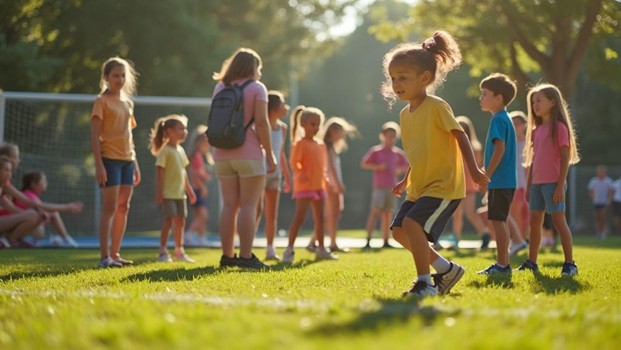Shift from Simple Play to Passionate Performance

When a child first kicks a soccer ball or picks up a paintbrush, the joy of discovery flows freely, unburdened by goals, points, or formal instruction. These early experiences are sparked by curiosity and rooted in play.
“Play is essential to development because it contributes to the cognitive, physical, social, and emotional well-being of children and youth.” — National Library of Medicine
As kids grow and talents develop, these experiences become more structured. This shift, commonly seen in domains like youth sports and creative pursuits, is not a loss of joy but an opportunity for growth. It’s where exploration meets discipline, and where purpose adds fuel to passion.
Rather than see this as a loss of spontaneity, today’s families and coaches are learning how to guide young athletes and performers toward excellence while preserving the spark that started their journey.
From Play to Performance: A Natural Evolution
The shift from free play to performance can be transformative. A backyard scrimmage turns into a weekend tournament. The best custom soccer jerseys symbolize teamwork, commitment, and identity.
In competitive youth sports, structured environments promote discipline, healthy competition, and strong social bonds. Children don’t just play, they learn to set goals, work as a team, and face challenges head-on. These experiences prepare them for life far beyond the field or court.
Still, preserving moments of fun and discovery within these environments is essential. Research supports the benefits of balancing high standards with playful engagement; for example, classroom behavior scores improve when students receive 15 minutes or more of active breaks during the school day.
What Shapes the Shift from Play to Performance?
Several contributing factors impact this transition:
- Coaching styles and feedback from mentors and peers
- Goal-oriented structure of organized athletic programs
- Emphasis on milestones, scores, and rankings
- Increased practice or travel commitments
Importantly, these are not inherently negative. They instill valuable life skills, resilience, time management, and perseverance when managed well.
The key lies in maintaining a player-first mindset and creating environments where passion drives ambition, not the other way around.
Active Kids, Healthy Lives: The Role of Sports
While some worry that structured activities might reduce natural movement, youth sports are one of the most effective ways to promote physical activity.
The physical environment is crucial in encouraging natural movement and spontaneous play. Quality play spaces can significantly affect activity levels, with improved amenities increasing energy expenditure by 0.42 kcal/kg/min per point increase in amenity score.
These findings demonstrate how thoughtfully designed spaces can promote active engagement and natural movement.
What helps?
- Thoughtfully designed public and school athletic facilities
- Support for sports in under-resourced communities
- Scheduling that balances training with rest and recovery
- Encouraging both organized and unstructured play
With the proper infrastructure and culture, sports programs offer much more than physical health; they support emotional growth, build confidence, and foster meaningful social bonds.
Managing Pressure: Supporting The Whole Athlete
Yes, performance can bring pressure. But that pressure, when framed positively, builds mental toughness and growth. Custom soccer jerseys represent far more than a uniform; they symbolize a team identity, a shared goal, and the pride of progress.
To help young athletes thrive, leading programs focus on mental wellness and perspective:
| Strategy | Purpose / Benefit |
| Goal-setting and celebrating small wins | Builds confidence through measurable progress and keeps motivation high |
| Visualization and breathwork | Helps reduce anxiety and sharpen focus before performance |
| Treating practice as a growth space | Encourages experimentation without fear of failure, fostering long-term skill development |
| Open communication with coaches/family | Creates a support network that helps athletes express stress, set boundaries, and feel seen |
Blending play and performance creates a powerful combination, where confidence grows not from perfection but progress.
Support Systems that Keep Kids in the Game
Support networks—coaches, parents, mental health professionals—play a crucial role in sustaining long-term engagement and preventing burnout.
Strong support systems help athletes:
- Balance school, sports, and social life
- Navigate setbacks with resilience
- Rediscover joy through flexible training plans
- Feel supported during high-pressure moments
By intentionally weaving enjoyment into structured environments, families and coaches ensure that sports remain where kids want to be, not just for points or trophies, but because they love the game.
Where Passion and Performance Coexist
The evolution from carefree play to structured performance isn’t a problem—it’s a progression. When thoughtful support, community values, and positive reinforcement guide the journey, youth sports become one of the most powerful tools for development.
Whether wearing your first team jersey or stepping confidently onto the field, sports unlock lessons that last a lifetime.
At their best, sports don’t replace joy—they refine it. They take what’s spontaneous and strengthen it with purpose, community, and pride.


